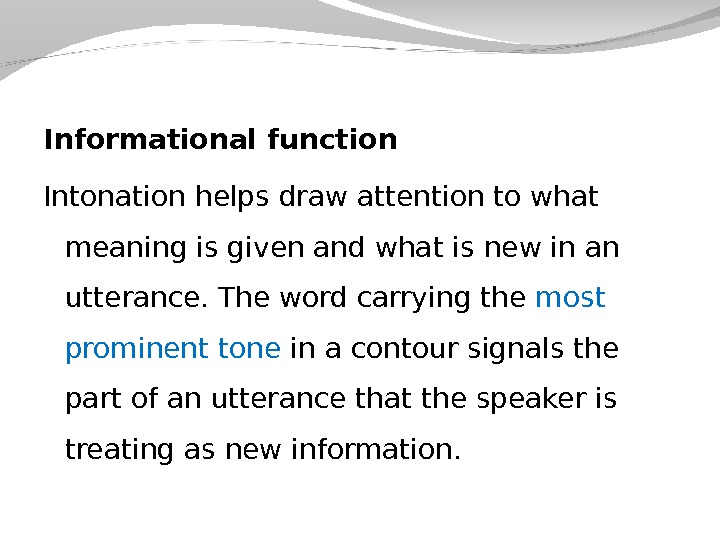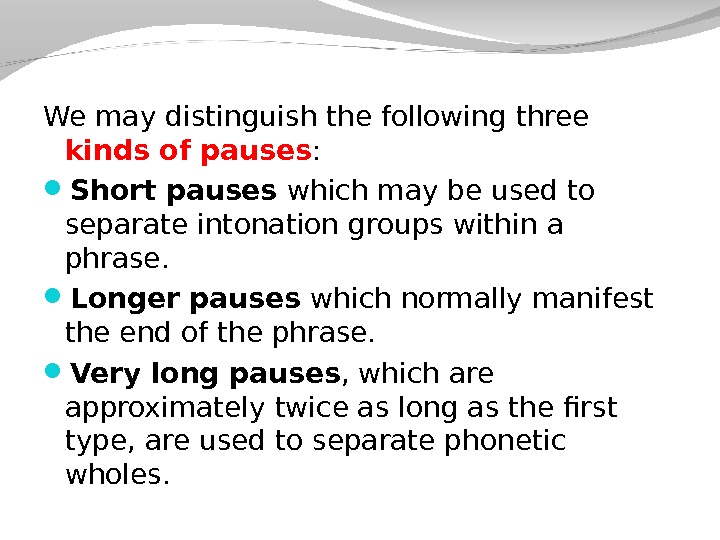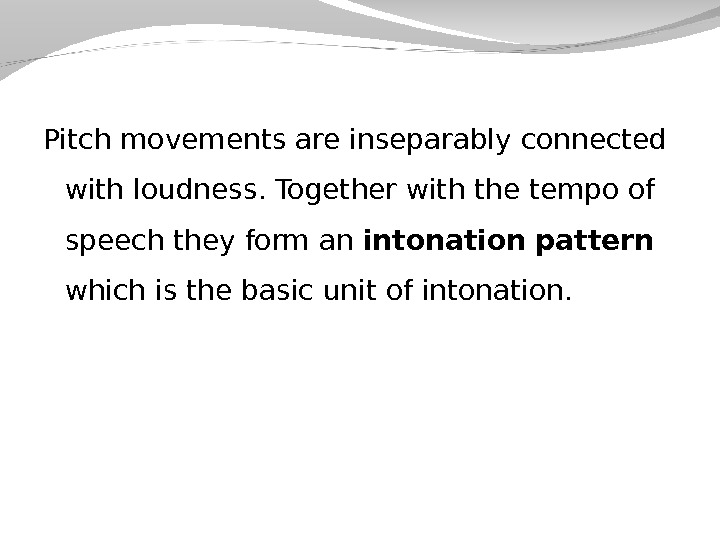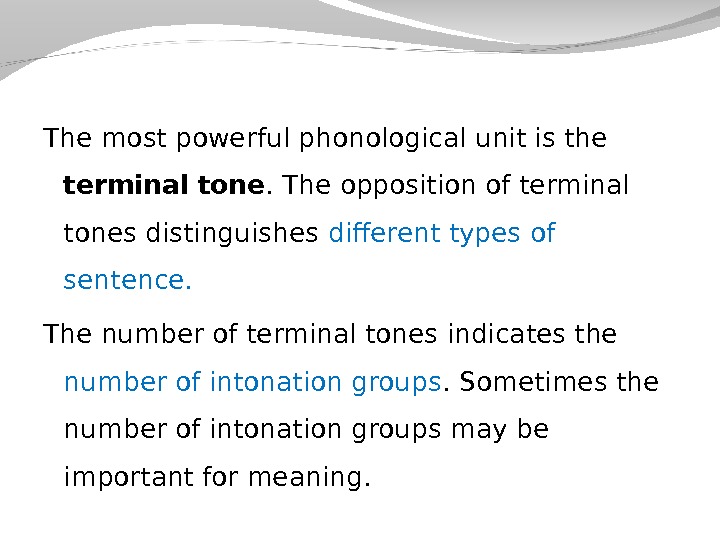• Intonation: Definition, Approaches, Functions. •
































































english_phonetics_lecture_6.ppt
- Размер: 350.5 Кб
- Количество слайдов: 63
Описание презентации • Intonation: Definition, Approaches, Functions. • по слайдам
 • Intonation: Definition, Approaches, Functions. • The Components of Intonation and the Structure of English Tone-Group. • The Phonological Aspect of Intonation.
• Intonation: Definition, Approaches, Functions. • The Components of Intonation and the Structure of English Tone-Group. • The Phonological Aspect of Intonation.
 Two main approaches to the problem of intonation: The contour analysis (H. Sweet, D. Jones, H. Palmer, L. Armstrong, I. Ward, R. Kingdon, J. D. O’Connor, A. C. Gimson) The grammatical approach (M. Halliday).
Two main approaches to the problem of intonation: The contour analysis (H. Sweet, D. Jones, H. Palmer, L. Armstrong, I. Ward, R. Kingdon, J. D. O’Connor, A. C. Gimson) The grammatical approach (M. Halliday).
 According to the contour analysis the smallest unit to which linguistic meaning can be attached is a tone-group (sense-group).
According to the contour analysis the smallest unit to which linguistic meaning can be attached is a tone-group (sense-group).
 According to the grammatical approach the main unit of intonation is a clause. Intonation is a complex of three systemic variables: tonality, tonicity and tone , which are connected with grammatical categories.
According to the grammatical approach the main unit of intonation is a clause. Intonation is a complex of three systemic variables: tonality, tonicity and tone , which are connected with grammatical categories.
 On perception level intonation is a complex, a whole, formed by significant variations of pitch , loudness and tempo closely related. Some linguists regard speech timbre as the fourth component of intonation.
On perception level intonation is a complex, a whole, formed by significant variations of pitch , loudness and tempo closely related. Some linguists regard speech timbre as the fourth component of intonation.
 M. O. Sokolova writes that the term prosody embraces the three prosodic components and substitutes the term intonation.
M. O. Sokolova writes that the term prosody embraces the three prosodic components and substitutes the term intonation.
 According to D. Crystal, the most important prosodic effects are those conveyed by the linguistic use of pitch movement , or melody.
According to D. Crystal, the most important prosodic effects are those conveyed by the linguistic use of pitch movement , or melody.
 FUNCTIONS OF INTONATION
FUNCTIONS OF INTONATION
 T. M. Nikolayeva: delimitating, integrating, semantic
T. M. Nikolayeva: delimitating, integrating, semantic
 L. K. Tseplitis: semantic, syntactic, stylistic
L. K. Tseplitis: semantic, syntactic, stylistic
 N. V. Cheremisina: communicative, distinctive (or phonological), delimitating, expressive, appellative, aesthetic, integrating
N. V. Cheremisina: communicative, distinctive (or phonological), delimitating, expressive, appellative, aesthetic, integrating
 D. Crystal: emotional grammatical informational textual psychological indexical
D. Crystal: emotional grammatical informational textual psychological indexical
 Emotional function Intonation’s most obvious role is to express attitudinal meaning -sarcasm, surprise, reserve, impatience, delight, shock, anger, interest, and thousands of other semantic nuances.
Emotional function Intonation’s most obvious role is to express attitudinal meaning -sarcasm, surprise, reserve, impatience, delight, shock, anger, interest, and thousands of other semantic nuances.
 Grammatical function Intonation helps to identify grammatical structure in speech, performing a role similar to punctuation.
Grammatical function Intonation helps to identify grammatical structure in speech, performing a role similar to punctuation.
 Informational function Intonation helps draw attention to what meaning is given and what is new in an utterance. The word carrying the most prominent tone in a contour signals the part of an utterance that the speaker is treating as new information.
Informational function Intonation helps draw attention to what meaning is given and what is new in an utterance. The word carrying the most prominent tone in a contour signals the part of an utterance that the speaker is treating as new information.
 Textual function Intonation helps larger units of meaning than the sentence to contrast and cohere. In radio news-reading, paragraphs of information can be shaped through the use of pitch.
Textual function Intonation helps larger units of meaning than the sentence to contrast and cohere. In radio news-reading, paragraphs of information can be shaped through the use of pitch.
 Psychological function Intonation helps us to organize speech into units that are easier to perceive and memorize.
Psychological function Intonation helps us to organize speech into units that are easier to perceive and memorize.
 Indexical function Intonation, along with other prosodic features, is an important marker of personal or social identity.
Indexical function Intonation, along with other prosodic features, is an important marker of personal or social identity.
 THE COMPONENTS OF INTONATION
THE COMPONENTS OF INTONATION
 The pitch component or speech melody – the variations in the pitch of the voice which take place when voice sounds, especially vowels and sonorants, are pronounced in connected speech. The pitch parameters consist of distinct variations in: direction of pitch, pitch level, pitch range.
The pitch component or speech melody – the variations in the pitch of the voice which take place when voice sounds, especially vowels and sonorants, are pronounced in connected speech. The pitch parameters consist of distinct variations in: direction of pitch, pitch level, pitch range.
 According to Roger Kingdon the most important nuclear tones in English relevant for the teaching practice are: Low Fall, High Fall, Low Rise, High Rise, Fall-Rise, Rise-Fall
According to Roger Kingdon the most important nuclear tones in English relevant for the teaching practice are: Low Fall, High Fall, Low Rise, High Rise, Fall-Rise, Rise-Fall
 Kinetic/Moving tones vs Static tones (the High Level Tone, the Low Level Tone) Simple tones (e. g. Low Fall) vs Complex tones (e. g. Rise-Fall, Rise-Fall-Rise)
Kinetic/Moving tones vs Static tones (the High Level Tone, the Low Level Tone) Simple tones (e. g. Low Fall) vs Complex tones (e. g. Rise-Fall, Rise-Fall-Rise)
 A falling tone of any level and range expresses certainty, completeness, and independence. A rising tone on the contrary expresses uncertainty, incompleteness or dependence. A level tone expresses hesitation and uncertainty.
A falling tone of any level and range expresses certainty, completeness, and independence. A rising tone on the contrary expresses uncertainty, incompleteness or dependence. A level tone expresses hesitation and uncertainty.
 The use of the Low Fall enables the speaker to convey in his utterance an impression of finality , definiteness , resoluteness. Phrases with the Low Fall sound categoric, calm, neutral, final.
The use of the Low Fall enables the speaker to convey in his utterance an impression of finality , definiteness , resoluteness. Phrases with the Low Fall sound categoric, calm, neutral, final.
 The use of the High Fall adds personal concern , interest and warmth to the features characteristic of the Low Fall. The High Fall sounds lively, interested and airy in statements. It sounds very emotional and warm, too.
The use of the High Fall adds personal concern , interest and warmth to the features characteristic of the Low Fall. The High Fall sounds lively, interested and airy in statements. It sounds very emotional and warm, too.
 The Low Rise conveys a feeling of non-finality, incompleteness, hesitation. Phrases pronounced with this tone sound not categoric, non-final, encouraging further conversation, wondering, mildly puzzled, soothing.
The Low Rise conveys a feeling of non-finality, incompleteness, hesitation. Phrases pronounced with this tone sound not categoric, non-final, encouraging further conversation, wondering, mildly puzzled, soothing.
 The High Rise expresses the speaker’s active searching for information. It is often used in echoed utterances, calling for repetition or additional information or with the intention to check if the information has been received correctly. Sometimes this tone is meant to keep the conversation going.
The High Rise expresses the speaker’s active searching for information. It is often used in echoed utterances, calling for repetition or additional information or with the intention to check if the information has been received correctly. Sometimes this tone is meant to keep the conversation going.
 The Fall-Rise may present a combination of two tones: either the Low Fall-Low Rise or the High Fall-Low Rise. The falling part marks the idea which the speaker wants to emphasize and the rising part marks the addition to this main idea. The speaker using this tone leaves something unsaid known both to him and his interlocutor.
The Fall-Rise may present a combination of two tones: either the Low Fall-Low Rise or the High Fall-Low Rise. The falling part marks the idea which the speaker wants to emphasize and the rising part marks the addition to this main idea. The speaker using this tone leaves something unsaid known both to him and his interlocutor.
 Statements with the Fall-Rise express correction of what someone else has said or a contradiction to something previously said or a warning. Imperatives pronounced this way sound pleading. Greetings and leave-takings sound pleasant and friendly being pronounced with the Fall-Rise
Statements with the Fall-Rise express correction of what someone else has said or a contradiction to something previously said or a warning. Imperatives pronounced this way sound pleading. Greetings and leave-takings sound pleasant and friendly being pronounced with the Fall-Rise
 The Rise-Fall denotes that the speaker is deeply impressed (favorably or unfavorably). Actually the Rise-Fall sometimes expresses the meaning of «even». It is used in statements and questions which sound impressed and challenging. Imperatives pronounced this way sound hostile and disclaiming responsibility.
The Rise-Fall denotes that the speaker is deeply impressed (favorably or unfavorably). Actually the Rise-Fall sometimes expresses the meaning of «even». It is used in statements and questions which sound impressed and challenging. Imperatives pronounced this way sound hostile and disclaiming responsibility.
 The Low Level tone is very characteristic of reading poetry. The Mid-Level tone is particularly common in spontaneous speech functionally replacing the rising tone. It is usually used in non-final intonation groups expressing non-finality without any expression of expectancy.
The Low Level tone is very characteristic of reading poetry. The Mid-Level tone is particularly common in spontaneous speech functionally replacing the rising tone. It is usually used in non-final intonation groups expressing non-finality without any expression of expectancy.
 Pitch ranges: normal wide narrow
Pitch ranges: normal wide narrow
 Pitch levels: high medium low
Pitch levels: high medium low
 Loudness is used in a variety of ways. Gross differences of meaning (such as anger, menace, and excitement) can be conveyed by using an overall loudness level.
Loudness is used in a variety of ways. Gross differences of meaning (such as anger, menace, and excitement) can be conveyed by using an overall loudness level.
 Sentence stress/utterance stress is the greater prominence of one or more words among other words in the sentence. It makes the force component of intonation.
Sentence stress/utterance stress is the greater prominence of one or more words among other words in the sentence. It makes the force component of intonation.
 According to Prof. Vassilyev the temporal component of intonation manifests itself in: pauses; duration (rate or tempo in speech); rhythm (in close combination with sentence stress).
According to Prof. Vassilyev the temporal component of intonation manifests itself in: pauses; duration (rate or tempo in speech); rhythm (in close combination with sentence stress).
 The rate of speech can be normal, slow, fast.
The rate of speech can be normal, slow, fast.
 We may distinguish the following three kinds of pauses : Short pauses which may be used to separate intonation groups within a phrase. Longer pauses which normally manifest the end of the phrase. Very long pauses , which are approximately twice as long as the first type, are used to separate phonetic wholes.
We may distinguish the following three kinds of pauses : Short pauses which may be used to separate intonation groups within a phrase. Longer pauses which normally manifest the end of the phrase. Very long pauses , which are approximately twice as long as the first type, are used to separate phonetic wholes.
 Functionally , there may be distinguished: syntactic pauses, emphatic pauses, hesitation pauses.
Functionally , there may be distinguished: syntactic pauses, emphatic pauses, hesitation pauses.
 Syntactic pauses separate phonopassages, phrases, and intonation groups. Emphatic pauses serve to make especially prominent certain parts of the utterance. Hesitation pauses are mainly used in spontaneous speech to gain some time to think over what to say next. They may be silent or filled.
Syntactic pauses separate phonopassages, phrases, and intonation groups. Emphatic pauses serve to make especially prominent certain parts of the utterance. Hesitation pauses are mainly used in spontaneous speech to gain some time to think over what to say next. They may be silent or filled.
 Pitch movements are inseparably connected with loudness. Together with the tempo of speech they form an intonation pattern which is the basic unit of intonation.
Pitch movements are inseparably connected with loudness. Together with the tempo of speech they form an intonation pattern which is the basic unit of intonation.
 Intonation patterns serve to actualize syntagms in oral speech. A sense-group or a syntagm is an elementary structural and meaningful segment of a text. It is a part of the utterance which is organized syntactically , has a definite meaning and is characterized by definite intonation means.
Intonation patterns serve to actualize syntagms in oral speech. A sense-group or a syntagm is an elementary structural and meaningful segment of a text. It is a part of the utterance which is organized syntactically , has a definite meaning and is characterized by definite intonation means.
 If the intonation properties of a sense-group are meant, the sense-group is called a tone unit /an intonation group. The intonation group is a stretch of speech which may have the length of the whole phrase. But the phrase often contains more than one intonation group.
If the intonation properties of a sense-group are meant, the sense-group is called a tone unit /an intonation group. The intonation group is a stretch of speech which may have the length of the whole phrase. But the phrase often contains more than one intonation group.
 The number of intonation groups depends on the length of the phrase and the degree of semantic importance or emphasis given to various parts of it.
The number of intonation groups depends on the length of the phrase and the degree of semantic importance or emphasis given to various parts of it.
 One of the syllables has the greater prominence than the others and forms the nucleus , or focal point of an intonation pattern.
One of the syllables has the greater prominence than the others and forms the nucleus , or focal point of an intonation pattern.
 Formally the nucleus may be described as a strongly stressed syllable which is generally the last strongly accented syllable of an intonation pattern and which marks a significant change of pitch direction.
Formally the nucleus may be described as a strongly stressed syllable which is generally the last strongly accented syllable of an intonation pattern and which marks a significant change of pitch direction.
 The tone of a nucleus determines the pitch of the rest of the intonation pattern following it which is called the tail. The nucleus and the tail form what is called terminal tone. The two other sections of the intonation pattern are the head and the pre-head which form the pre-nuclear part of the intonation pattern.
The tone of a nucleus determines the pitch of the rest of the intonation pattern following it which is called the tail. The nucleus and the tail form what is called terminal tone. The two other sections of the intonation pattern are the head and the pre-head which form the pre-nuclear part of the intonation pattern.
 Common types of pr е -nucleus: a descending type in which the pitch gradually descends (often in «steps») to the nucleus; an ascending type in which the syllables form an ascending sequence; a level type when all the syllables stay more or less on the same level.
Common types of pr е -nucleus: a descending type in which the pitch gradually descends (often in «steps») to the nucleus; an ascending type in which the syllables form an ascending sequence; a level type when all the syllables stay more or less on the same level.
 The meaning of the intonation group is the combination of the «meaning» of the terminal tone and the pre-nuclear part combined with the «meaning» of pitch range and pitch level.
The meaning of the intonation group is the combination of the «meaning» of the terminal tone and the pre-nuclear part combined with the «meaning» of pitch range and pitch level.
 Prosodic components tend to become formalized or standardized , so that all speakers of the language use them in similar ways under similar circumstances. These abstracted characteristics of intonation structures may be called intonation patterns which form the prosodic system of English.
Prosodic components tend to become formalized or standardized , so that all speakers of the language use them in similar ways under similar circumstances. These abstracted characteristics of intonation structures may be called intonation patterns which form the prosodic system of English.
 Intonation patterns which are completely colourless in meaning and provide a mold into which all sentences may be poured so that they achieve utterance represent the intonational minimum of speech.
Intonation patterns which are completely colourless in meaning and provide a mold into which all sentences may be poured so that they achieve utterance represent the intonational minimum of speech.
 THE PHONOLOGICAL ASPECT OF INTONATION Phonology has a special branch, intonology , whose domain is the larger units of connected speech: intonation groups , phrases and even phonetic passages or blocks of discourse.
THE PHONOLOGICAL ASPECT OF INTONATION Phonology has a special branch, intonology , whose domain is the larger units of connected speech: intonation groups , phrases and even phonetic passages or blocks of discourse.
 Descriptions differ according to the kind of meaning they regard intonation is carrying and also according to the significance they attach to different parts of the tone-unit.
Descriptions differ according to the kind of meaning they regard intonation is carrying and also according to the significance they attach to different parts of the tone-unit.
 J. D. O’Connor and G. F. Arnold assert that a major function of intonation is to express the speaker’s attitude to the situation he/she is placed in. They attach meanings not to pre-head, head and nucleus separately, but to each of ten ‘tone-unit types’ as they combine with each of four sentence types (statement, question, command exclamation).
J. D. O’Connor and G. F. Arnold assert that a major function of intonation is to express the speaker’s attitude to the situation he/she is placed in. They attach meanings not to pre-head, head and nucleus separately, but to each of ten ‘tone-unit types’ as they combine with each of four sentence types (statement, question, command exclamation).
 M. Halliday supposes that English intonation contrasts are grammatical. He argues first that there is a neutral or unmarked tone choice and then explains all other choices as meaningful by contrast. Halliday attributes separate significance to the pr е -nuclear choices.
M. Halliday supposes that English intonation contrasts are grammatical. He argues first that there is a neutral or unmarked tone choice and then explains all other choices as meaningful by contrast. Halliday attributes separate significance to the pr е -nuclear choices.
 D. Crystal presents an approach based on the view «that any explanation of intonational meaning cannot be arrived at by seeing the issues solely in either grammatical or attitudinal terms». He ignores the significance of pre-head and head choices and deals only with terminal tones.
D. Crystal presents an approach based on the view «that any explanation of intonational meaning cannot be arrived at by seeing the issues solely in either grammatical or attitudinal terms». He ignores the significance of pre-head and head choices and deals only with terminal tones.
 The distinctive function of intonation is realized in the opposition of the same word sequences which differ in certain parameters of the intonation pattern. Any section of the intonation pattern, any of its three constituents can perform the distinctive function thus being phonological units.
The distinctive function of intonation is realized in the opposition of the same word sequences which differ in certain parameters of the intonation pattern. Any section of the intonation pattern, any of its three constituents can perform the distinctive function thus being phonological units.
 The most powerful phonological unit is the terminal tone. The opposition of terminal tones distinguishes different types of sentence. The number of terminal tones indicates the number of intonation groups. Sometimes the number of intonation groups may be important for meaning.
The most powerful phonological unit is the terminal tone. The opposition of terminal tones distinguishes different types of sentence. The number of terminal tones indicates the number of intonation groups. Sometimes the number of intonation groups may be important for meaning.
 Together with the increase of loudness terminal tones serve to single out the semantic centre of the utterance which may simultaneously concentrate the expression of attitudes and feelings.
Together with the increase of loudness terminal tones serve to single out the semantic centre of the utterance which may simultaneously concentrate the expression of attitudes and feelings.
 The opposition of the distribution of terminal tones is fulfilling the distinctive function. It was an unusually rainy day. It was an unusually rainy day. It was an unusually rainy day. It was an unusually rainy day.
The opposition of the distribution of terminal tones is fulfilling the distinctive function. It was an unusually rainy day. It was an unusually rainy day. It was an unusually rainy day. It was an unusually rainy day.
 The most important role of the opposition of terminal tones is that of differentiating the attitudes and emotions expressed by the speaker.
The most important role of the opposition of terminal tones is that of differentiating the attitudes and emotions expressed by the speaker.
 Commonly different kinds of pre-heads, the same as pitch ranges and levels fulfill their distinctive function not alone but in the combination with other prosodic constituents.
Commonly different kinds of pre-heads, the same as pitch ranges and levels fulfill their distinctive function not alone but in the combination with other prosodic constituents.
 Intonation may be in contradiction with the syntactic structure and the lexical content of the utterance neutralizing and compensating them. Lack of balance between intonation and word content, or intonation and the grammatical structure of the utterance may serve special speech effects.
Intonation may be in contradiction with the syntactic structure and the lexical content of the utterance neutralizing and compensating them. Lack of balance between intonation and word content, or intonation and the grammatical structure of the utterance may serve special speech effects.

